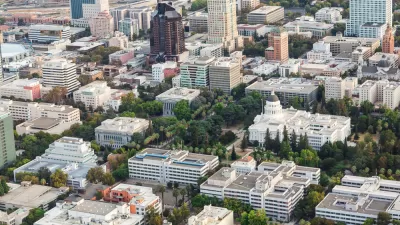Fewer babies are being born in the nation's most populous state, now estimated at 39.4 million residents, according to new data by the California Department of Finance. The state grew by .75 percent, adding 295,000 people in the year ending July 1.

"As California’s population grew to 39.4 million this year, its birth rate dipped to an all-time low amid the mounting challenges of raising a family, according to state data released Monday — a decline that some say threatens future economic growth and prosperity," reports Kurtis Alexander for the San Francisco Chronicle.
California’s low birth rates are helping prolong a decade-long trend of minimal population growth. The 0.75 percent increase between July of 2015 and 2016 marks 12 consecutive years that the state has gone without a bump above 1 percent.** That’s a far cry from last century’s growth, which at times soared to 3 percent or more annually.
"The birth rate declined to 12.42 births per 1,000 population from 13.69 births per 1,000 population in 2010 Census - the lowest level in California’s history," states the Dec. 19 press release [PDF]. "The rate surpassed the previous record low of 12.6 births for every 1,000 people set in 1933, during the throes of the Great Depression," adds Alexander.
Total growth, meaning births minus deaths [225,000] plus net migration [70,000], resulted in an increase of 295,000 people between July 1, 2015 and July 1, 2016. That's down from 335,000 in people in 2014 when the birth rate was 12.4. Births accounted for 76 percent of the increase.
As in past years, domestic migration, meaning the difference between people moving to California from other states and residents leaving for other states, remained a negative figure: (118,000), with high housing costs being a prime reason. Immigration from other countries resulted in an increase of 188,000 people. Net migration accounted for 24 percent of the population increase.
Walter Schwarm, a demographer with the Department of Finance, explained the reduced population growth as symptomatic of California's maturation:
“In the ’70s and ’80s, we were pretty much a new state, with plenty of opportunity and open land, and many people came here,” said Schwarm. “Now, we look like a state that isn’t at that point anymore. We’re a mature state.”
Where there is plenty of open land, in the Central Valley and Inland Empire, the growth rates were the highest: See table on pg. 3 and map on pg. 17 in press release [PDF].
To address the slow-down, "[p]ro-growth policies such as increasing the housing stock and expanding child tax credits have been proposed," writes Alexander. "So have plans to encourage immigration, especially among highly-educated foreigners. But each of these efforts comes with financial and political challenges."
Los Angeles County, with a population of 10,229,245 on July 1, is home to 25.99 percent of the state's population. It had the largest numeric population increase of 43,758, but among the state's 58 counties, had the 36th highest growth rate: .43 percent. Yolo County, just west of Sacramento, was the fastest growing with a rate of 1.97 percent.
California is growing less than the country as a whole, which was estimated at .77 percent for the 12 months ending November 2016 according to the multpl economic data provider.
Hat tip to Mike McPhate, columnist for the New York Times California Today update.
Footnote: **Note that the 2009 post below (#8) indicates that the 2008 and 2007 population growth rates were 1.1 percent and 1.3 percent respectively. However, these numbers are revised after their initial release. Look for a forthcoming explanation in a comment below the post.
Related Planetizen posts on California population growth, from most recent to oldest:
- California's Population Now Tops 39 Million, December 23, 2015: New figures released by the California Department of Finance show that the state grew by 346,000 (to July 1, 2015). As in past years, the increase comes from natural births and immigration while more left the state than entered.
- California's High Housing Costs Drives Out-Migration, January 7, 2015: Same story, different year, though more data provided on which groups are leaving the Golden State: predominantly workers earning less than $50,000 a year. Conversely, those migrating to California from other states had higher incomes and education.
- California's Moderate Population Growth: The New Normal, December 13, 2014: New demographic data released Dec. 11 by the state Department of Finance shows the state grew by 335,000 people to 38.5 million, nearly one percent, despite a declining birth rate. While the most in six years, the growth rate has slowed overall.
- The Great California Exodus? Not So!, May 20, 2012: Is it a calamity that more Californians are leaving the state than are migrating there from others? USC demographer Dowell Myers takes a closer look at migration data and finds that most native-born Californians remain there.
-
The Bright Side of California's Growth Slowdown: April 27, 2012: According to a just-released report from USC, CA's population, currently 37.5 million, will reach 50 million in the year 2046, a full 14 years later than the 2007 Dept. of Finance projection, due to the major growth slowdown shown in 2010 Census.
-
Planners Driving Californians Out Of State, April 9, 2012: In this opinion piece, transportation consultant Wendell Cox explains why residents are fleeing CA in droves. By not providing single family homes Cox feels most want, residents must find their quarter-acre lots elsewhere. He blames regional plans.
-
Population Growth Slows Dramatically in California, Including Fewer Births, December 9, 2011: Not only are more Californians leaving the state for greener pastures than those moving to it, but the birth rate is dropping as well according to a detailed new demographic report by county on 2010-2011 growth by the state Department of Finance.
-
California Population Growth Continues To Slow, May 7, 2009: California's population growth slowed to 1.1% according to the state Dept. of Finance, down from 1.3% last year. Current population is 38.3 million. The LA Times looks at southern CA growth while the SF Chronicle reports on Bay Area growth.
FULL STORY: California’s birthrate has dipped to a record low

Planetizen Federal Action Tracker
A weekly monitor of how Trump’s orders and actions are impacting planners and planning in America.

Maui's Vacation Rental Debate Turns Ugly
Verbal attacks, misinformation campaigns and fistfights plague a high-stakes debate to convert thousands of vacation rentals into long-term housing.

Restaurant Patios Were a Pandemic Win — Why Were They so Hard to Keep?
Social distancing requirements and changes in travel patterns prompted cities to pilot new uses for street and sidewalk space. Then it got complicated.

In California Battle of Housing vs. Environment, Housing Just Won
A new state law significantly limits the power of CEQA, an environmental review law that served as a powerful tool for blocking new development.

Boulder Eliminates Parking Minimums Citywide
Officials estimate the cost of building a single underground parking space at up to $100,000.

Orange County, Florida Adopts Largest US “Sprawl Repair” Code
The ‘Orange Code’ seeks to rectify decades of sprawl-inducing, car-oriented development.
Urban Design for Planners 1: Software Tools
This six-course series explores essential urban design concepts using open source software and equips planners with the tools they need to participate fully in the urban design process.
Planning for Universal Design
Learn the tools for implementing Universal Design in planning regulations.
Heyer Gruel & Associates PA
JM Goldson LLC
Custer County Colorado
City of Camden Redevelopment Agency
City of Astoria
Transportation Research & Education Center (TREC) at Portland State University
Jefferson Parish Government
Camden Redevelopment Agency
City of Claremont





























